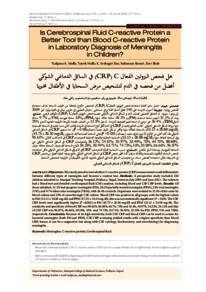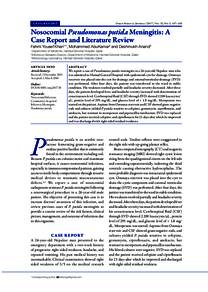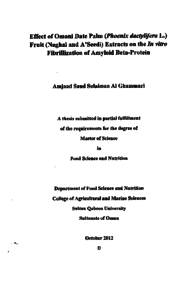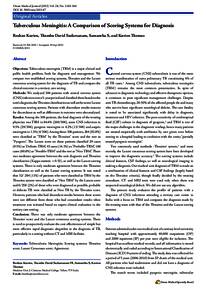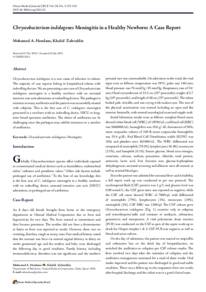وثيقة
Is cerebrospinal fluid C-reactive protein a better tool than blood C-reactive protein in laboratory diagnosis of meningitis in children?.
المساهمون
عناوين أخرى
هل فحص البروتين الفعال (CRP) C في السائل الدامغي الشوكي أفضل من فحصه في الدم لتشخيص مرض السحايا في الأطفال مخبريا
الناشر
College of Medicine, Sultan Qaboos University.
ميلادي
2013-02
اللغة
الأنجليزية
الملخص الإنجليزي
Objectives: This study aimed to test whether C-reactive protein (CRP) measurement could differentiate
between different types of meningitis and become a routine test. Methods: A prospective study included 140
children admitted to Manipal Teaching Hospital, Pokhara, Nepal, between July 2009 and June 2011. The subjects
had a blood test and detailed cerebrospinal fluid (CSF) analysis, including blood and CSF CRP levels. Results: Of
those admitted, 31.1% had pyogenic meningitis (PM), 26.2% partially treated meningitis (PPM), 33% viral meningitis
(VM), and 9.7% tubercular meningitis (TBM), with 26.4% controls. Organisms were isolated in 12.5% of the cases by
blood culture and 25% of cases through CSF culture. Blood CRP was positive in all groups, with the highest values
in PM (53.12 ± 28.88 mg/dl) and PPM (47.55 ± 34.34 mg/dl); this was not statistically significant (P = 0.08). The CSF
CRP levels were significantly higher (P <0.001) in PM (45.75 ± 28.50 mg/dl) and PPM (23.11 ± 23.98 mg/dl). The
sensitivity and specificity of blood CRP was 90.62%, 88.88%, 64.7%, 70% and 32.4%, 30.97%, 24.52%, 26.12% and that
of CSF CRP was 96.87%, 66.66%, 20.58%, 10% and 74.73%, 63.71%, 50.94%, 55.35% for PM, PPM, VM and TBM,
respectively. Conclusion: Because of its high sensitivity, both CSF CRP and blood CRP can be used to screen for
bacterial meningitis (both PM and PPM). CSF CRP screening yielded results with a higher specificity than blood
CRP; hence, it can be a supportive test along with CSF cytology, biochemistry, and microbiology for diagnosing
meningitis.
برعاية
Sultan Qaboos University
المجموعة
URL المصدر
zcustom_txt_2
Malla, Kalpana K., Malla, Tejesh, Rao, K. Sishagiri, Basnet, Sahisnuta, & Shah, Ravi (2013). Is cerebrospinal fluid C-reactive protein a better tool than blood C-reactive protein in laboratory diagnosis of meningitis in children?. Sultan Qaboos University
الملخص العربي
الهدف: اختبار كفاءة استخدام فحص البروتين الفعال C (CPRP) لتشخيص الأنواع المختلفة من التهاب السحايا بهدف استخدام الفحص روتينيا. الطريقة: أجريت الدراسة على 140 طفلا أدخلوا للعلاج في مستشفى مانيبال التعليمي في بخارى، نيبال في الفترة يوليو/ تموز 2009 إلى يونيو حزيران. تم التحليل التفصيلي لعينات الدم والسائل الدماغي الشوكي متضمنا فحص البروتين الفعال C (CPRP). النتائج: وجد أن % 31.1 لديهم سحايا صديدية، و % 26.2 سحايا معالجه جزئيا، و% 33 سحايا فيروسيه، و % 9.7 سحايا السل، 26.4% غير مرضي تم استخدامهم كضوابط للدراسة. تم عزل % 12.5 من العينات المصابة بالزراعة الجرثوميه المخبريه للدم و % 25 منها بزراعة السائل الدماغي الشوكي. كانت النتائج إيجابيه لCRP في الدم لكل أنواع السحايا في الدراسة وكانت أعلى نسبه ايجابيه في السحايا الصديدية ولكن لم يكن الفرق معتمد إحصائيا (P= 0.08). أما مستوى CRP في السائل الدماغي الشوكي فقد كان أعلى من الأنواع الأخرى بفارق معتمد إحصائيا (P< 0.001). الاستنتاج: بسبب الحساسية العالية لفحوص CRP في الدم وفي السائل الدماغي الشوكي يمكن استخدامه لفحص السحايا البكتيرية (الصديدة والمعالجة جزئيا). لقد أظهر فحص CRP في السائل الدماغي الشوكي نتائج بنوعية تحليلية أفضل من فحص CRP في الدم ولهذا يمكن استخدامه كفحص مساند مع فحوصات السائل الدماغي الشوكي المخبرية الأخرى الكيميائية والجرثومية لتشخيص السحايا.
قالب العنصر
مقالات الدوريات

